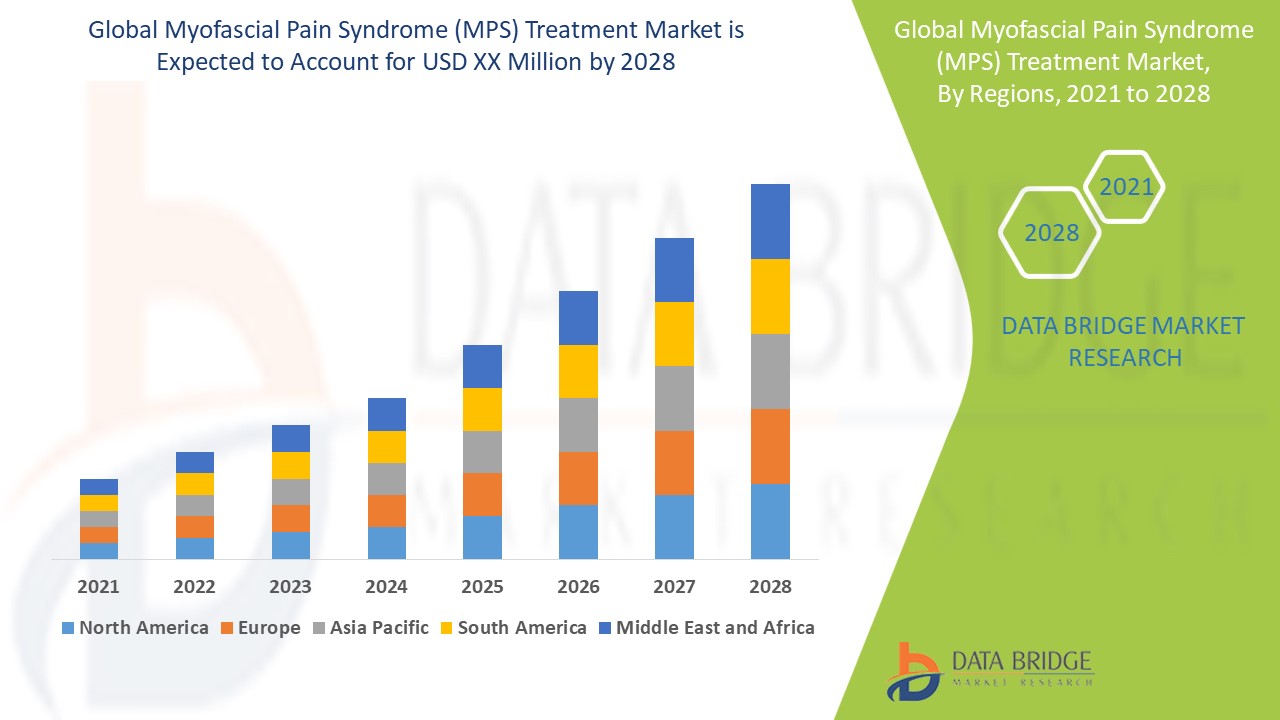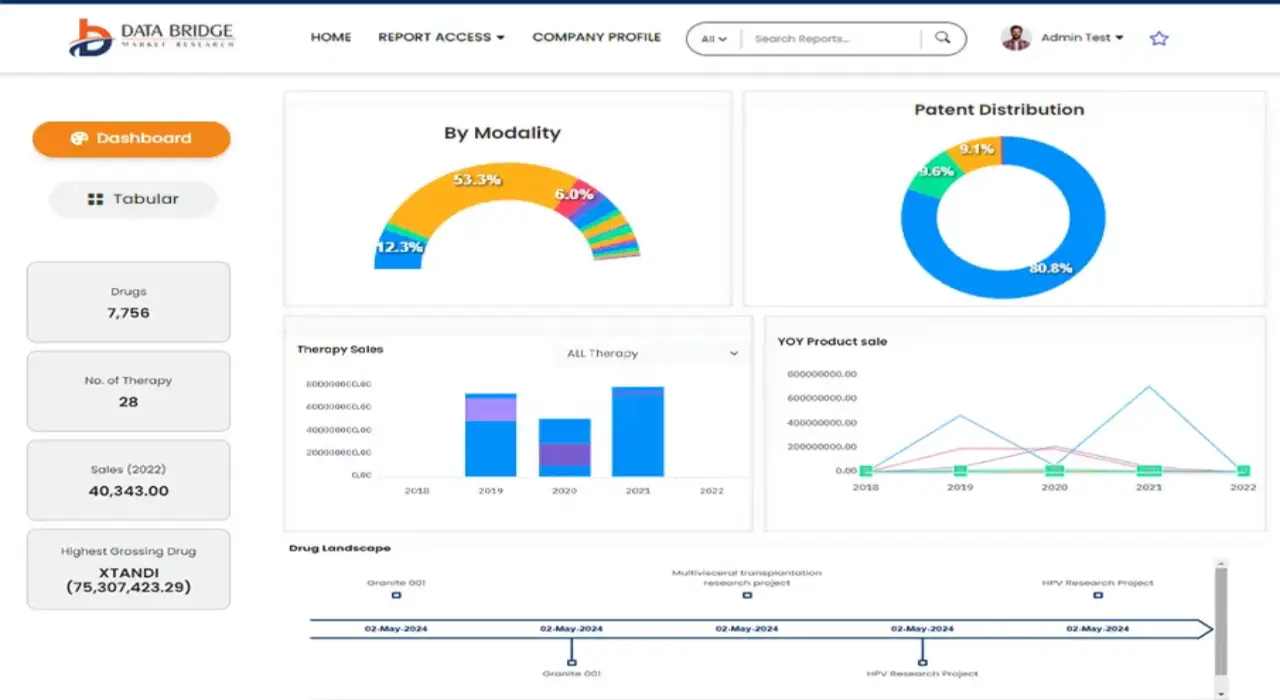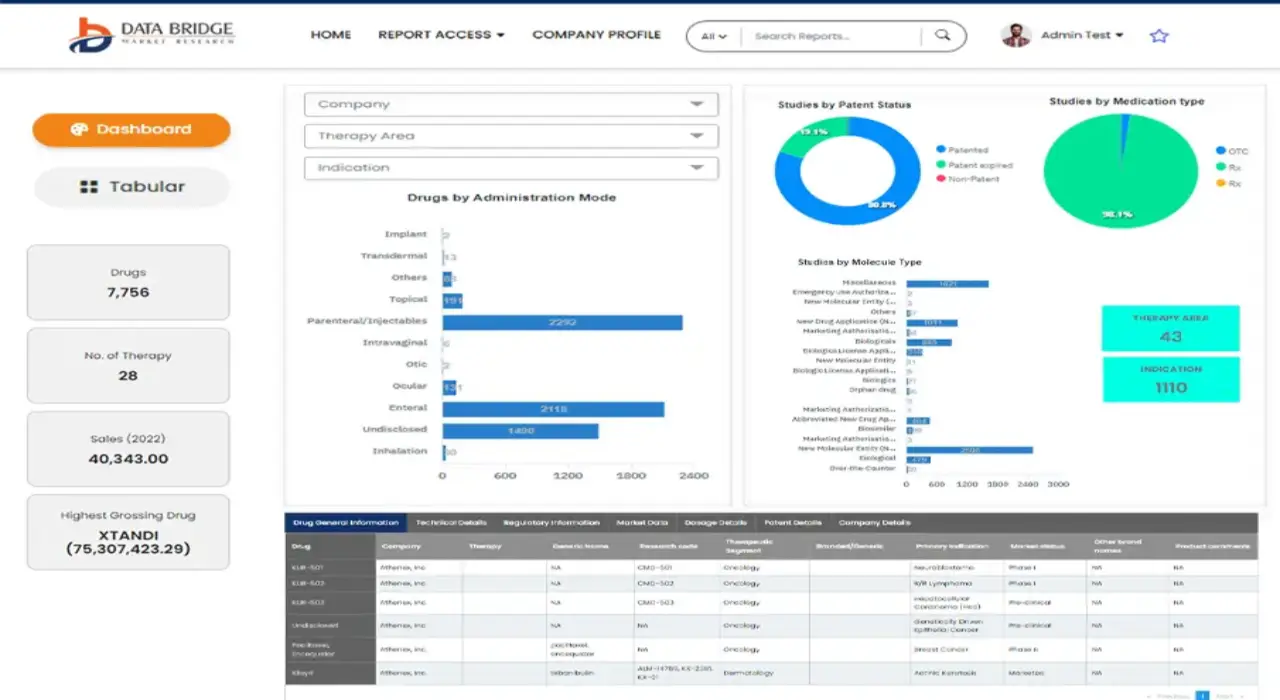Global Myofascial Pain Syndrome Mps Treatment Market
Market Size in USD Billion
CAGR :
% 
 USD
1.11 Billion
USD
2.23 Billion
2024
2032
USD
1.11 Billion
USD
2.23 Billion
2024
2032
| 2025 –2032 | |
| USD 1.11 Billion | |
| USD 2.23 Billion | |
|
|
|
|
Global Myofascial Pain Syndrome (MPS) Treatment Market Segmentation, By Treatment (Pharmacologic Treatment and Non Pharmacologic Treatment), Route of Administration (Oral, Parenteral, and Others), End-Users (Clinics, Hospitals, Homecare, and Others), Distribution Channel (Hospital Pharmacy, Retail Pharmacy, Online Pharmacy, and Others) – Industry Trends and Forecast to 2032
Myofascial Pain Syndrome (MPS) Treatment Market Analysis
The myofascial pain syndrome (MPS) treatment market is experiencing steady growth, driven by the increasing prevalence of chronic pain conditions and rising awareness about effective management options. Myofascial pain syndrome, characterized by localized muscle pain and trigger points, requires a multidisciplinary treatment approach, including pharmacological therapies, physical therapy, and advanced interventions such as dry needling and laser therapy. Recent developments include innovative drug delivery systems and minimally invasive treatment methods that enhance patient outcomes. In addition, the adoption of technologies such as ultrasound-guided procedures is improving the precision of interventions. With the growing demand for non-invasive treatments and advancements in pain management strategies, the market is expected to expand further. Emerging economies are witnessing increased adoption due to improved healthcare access and rising patient awareness. Overall, the MPS treatment market is poised for significant growth, fueled by innovation and the rising need for effective pain management solutions.
Myofascial Pain Syndrome (MPS) Treatment Market Size
The global myofascial pain syndrome (MPS) treatment market size was valued at USD 1.11 billion in 2024 and is projected to reach USD 2.23 billion by 2032, with a CAGR of 8.49% during the forecast period of 2025 to 2032. In addition to the insights on market scenarios such as market value, growth rate, segmentation, geographical coverage, and major players, the market reports curated by the Data Bridge Market Research also include depth expert analysis, patient epidemiology, pipeline analysis, pricing analysis, and regulatory framework.
Myofascial Pain Syndrome (MPS) Treatment Market Trends
“Integration of Ultrasound-Guided Interventions”
The myofascial pain syndrome (MPS) treatment market is evolving with advancements in pain management technologies and growing awareness about effective therapies. MPS, a condition involving chronic muscle pain and trigger points, demands diverse treatment options ranging from pharmacological solutions to physical and minimally invasive therapies. One notable trend is the integration of ultrasound-guided interventions, enabling precise identification and treatment of trigger points, which enhances patient outcomes and reduces recovery time. In addition, innovations such as laser therapy and drug delivery patches are reshaping the market, offering non-invasive and patient-friendly alternatives. As the demand for personalized and efficient pain management grows, these technological advancements are driving the expansion and transformation of the MPS treatment market.
Report Scope and Myofascial Pain Syndrome (MPS) Treatment Market Segmentation
|
Attributes |
Myofascial Pain Syndrome (MPS) Treatment Key Market Insights |
|
Segments Covered |
|
|
Countries Covered |
U.S., Canada and Mexico in North America, Germany, France, U.K., Netherlands, Switzerland, Belgium, Russia, Italy, Spain, Turkey, Rest of Europe in Europe, China, Japan, India, South Korea, Singapore, Malaysia, Australia, Thailand, Indonesia, Philippines, Rest of Asia-Pacific (APAC) in the Asia-Pacific (APAC), Saudi Arabia, U.A.E., South Africa, Egypt, Israel, Rest of Middle East and Africa (MEA) as a part of Middle East and Africa (MEA), Brazil, Argentina and Rest of South America as part of South America. |
|
Key Market Players |
Bliss GVS (India), Samyang Holdings Corporation (South Korea), Jenburkt Pharmaceuticals Limited (India), Nemaura (U.K.), GSK plc (U.K.), Teva Pharmaceutical Industries Ltd. (Israel), Acino International AG (Switzerland), Sun Pharmaceutical Industries Ltd. (India), Avenue Therapeutics (U.S.), Janssen Scientific Affairs, LLC (U.S.), Dr. Reddy’s Laboratories Ltd. (India), Teikoku Pharma (U.S.), Scilex Holding (U.S.), Amneal Pharmaceuticals LLC (U.S.), Pfizer Inc. (U.S.), Afton Pharma (U.S.), Natco Pharma (Canada) Inc. (Canada), Eli Lilly and Company (U.S.), Aurobindo Pharma Limited (India), Cutting Edge Laser Technologies (U.S.), eToims (U.S.), Hollar Chiropractic & Rehab (U.S.) |
|
Market Opportunities |
|
|
Value Added Data Infosets |
In addition to the insights on market scenarios such as market value, growth rate, segmentation, geographical coverage, and major players, the market reports curated by the Data Bridge Market Research also include depth expert analysis, patient epidemiology, pipeline analysis, pricing analysis, and regulatory framework. |
Myofascial Pain Syndrome (MPS) Treatment Market Definition
Myofascial pain syndrome (MPS) treatment refers to the medical and therapeutic approaches used to manage and alleviate chronic muscle pain caused by myofascial trigger points—sensitive areas of tight muscle fibers. Treatments typically include pharmacological options such as analgesics and muscle relaxants, physical therapies such as massage and stretching, and advanced interventions such as dry needling, laser therapy, or ultrasound-guided injections. The goal is to relieve pain, restore muscle function, and improve the quality of life for affected individuals.
Myofascial Pain Syndrome (MPS) Treatment Market Dynamics
Drivers
- Rising Prevalence of Chronic Pain Disorders
The rising incidence of chronic muscle pain and lifestyle-related disorders has significantly increased the demand for effective treatments for myofascial pain syndrome (MPS). Sedentary lifestyles, prolonged desk jobs, and lack of physical activity are key contributors to muscle stress and trigger point development. In addition, conditions such as obesity and poor posture exacerbate the prevalence of MPS. With growing awareness about the importance of timely pain management, patients are actively seeking advanced and reliable therapeutic options. This trend highlights a critical driver for the MPS treatment market, as healthcare providers and manufacturers innovate to meet the increasing need for effective pain management solutions.
- Increasing Demand for Non-Invasive Treatments
The growing preference for non-invasive and minimally invasive treatment options is a significant driver of the myofascial pain syndrome (MPS) treatment market. Patients increasingly seek therapies that offer effective pain relief with minimal discomfort and shorter recovery times. Advanced techniques such as laser therapy, ultrasound-guided procedures, and dry needling are gaining popularity for their precision and reduced invasiveness. These methods enhance patient satisfaction and lower the risk of complications associated with traditional approaches. This shift reflects the market's response to patient demand for safer, more accessible solutions, further driving the adoption of innovative MPS treatment modalities.
Opportunities
- Increased Focus on Homecare Solutions
The growing demand for at-home pain management tools and therapies presents a significant opportunity for the myofascial pain syndrome (MPS) treatment market. With patients seeking convenient and cost-effective alternatives to frequent clinical visits, the adoption of portable and user-friendly devices, such as handheld massagers, TENS units, and wearable pain relief technologies, is on the rise. This trend is further fueled by advancements in telemedicine and digital health platforms, which support remote monitoring and guidance for pain management. Manufacturers have a unique opportunity to innovate and provide affordable, effective solutions tailored for homecare, addressing a critical gap in the MPS treatment landscape.
- Integration of Digital Health Technologies
The integration of apps and devices for monitoring and managing pain offers a promising opportunity for growth in the myofascial pain syndrome (MPS) treatment market. Digital health technologies, such as mobile apps and wearable devices, enable real-time tracking of pain levels, treatment progress, and therapy adherence. These tools facilitate personalized treatment plans by providing actionable insights to both patients and healthcare providers. In addition, features such as reminders and guided exercises improve patient engagement and outcomes. As demand for tech-driven healthcare solutions increases, manufacturers and developers have a unique chance to innovate and capitalize on the shift toward personalized and efficient pain management.
Restraints/Challenges
- Lack of Standardized Treatment Protocol
The lack of universally accepted guidelines for myofascial pain syndrome (MPS) treatment poses a significant challenge to the market. With no standardized protocol for managing MPS, healthcare providers may adopt varying approaches, making it difficult for patients to access the most effective therapies. This inconsistency can lead to delays in treatment, suboptimal outcomes, and increased healthcare costs. Furthermore, the absence of clear guidelines complicates the decision-making process for physicians, leading to the potential misuse or underuse of advanced therapies. This lack of standardization hampers market growth by limiting the adoption of effective treatment methods and slowing the development of new, innovative solutions.
- High Treatment Costs
The high cost of innovative therapies and advanced treatment options for myofascial pain syndrome (MPS) represents a significant restraint in the market. While these therapies, such as advanced injection techniques or specialized pain management devices, may offer effective relief, their high prices often make them inaccessible to a large portion of the patient population. This issue is particularly prevalent in low-income regions, where healthcare budgets are limited, and patients may struggle to afford these treatments. The cost barrier limits the widespread adoption of these therapies and poses a challenge to market growth, as affordability remains a critical factor in expanding access to effective MPS management.
This market report provides details of new recent developments, trade regulations, import-export analysis, production analysis, value chain optimization, market share, impact of domestic and localized market players, analyses opportunities in terms of emerging revenue pockets, changes in market regulations, strategic market growth analysis, market size, category market growths, application niches and dominance, product approvals, product launches, geographic expansions, technological innovations in the market. To gain more info on the market contact Data Bridge Market Research for an Analyst Brief, our team will help you take an informed market decision to achieve market growth.
Myofascial Pain Syndrome (MPS) Treatment Market Scope
The market is segmented on the basis of treatment, route of administration, end-users, and distribution channel. The growth amongst these segments will help you analyse meagre growth segments in the industries and provide the users with a valuable market overview and market insights to help them make strategic decisions for identifying core market applications.
Treatment
- Pharmacologic Treatment
- Non-Pharmacologic Treatment
Route of Administration
- Oral
- Parenteral
- Others
End-Users
- Clinics
- Hospitals
- Homecare
- Others
Distribution Channel
- Hospital Pharmacy
- Retail Pharmacy
- Online Pharmacy
- Others
Myofascial Pain Syndrome (MPS) Treatment Market Regional Analysis
The market is analysed and market size insights and trends are provided by country, treatment, route of administration, end-users, and distribution channel as referenced above.
The countries covered in the market report are U.S., Canada and Mexico in North America, Germany, France, U.K., Netherlands, Switzerland, Belgium, Russia, Italy, Spain, Turkey, Rest of Europe in Europe, China, Japan, India, South Korea, Singapore, Malaysia, Australia, Thailand, Indonesia, Philippines, Rest of Asia-Pacific (APAC) in the Asia-Pacific (APAC), Saudi Arabia, U.A.E., South Africa, Egypt, Israel, Rest of Middle East and Africa (MEA) as a part of Middle East and Africa (MEA), Brazil, Argentina and Rest of South America as part of South America.
Asia-Pacific is projected to dominate the myofascial pain syndrome (MPS) treatment market in the coming years, driven by a growing geriatric population and rising per capita income. In addition, improvements in healthcare infrastructure across the region are enhancing access to effective treatments. These factors are expected to accelerate market growth and make Asia-Pacific a key player in the global MPS treatment market.
The country section of the report also provides individual market impacting factors and changes in regulation in the market domestically that impacts the current and future trends of the market. Data points such as down-stream and upstream value chain analysis, technical trends and porter's five forces analysis, case studies are some of the pointers used to forecast the market scenario for individual countries. Also, the presence and availability of global brands and their challenges faced due to large or scarce competition from local and domestic brands, impact of domestic tariffs and trade routes are considered while providing forecast analysis of the country data.
Myofascial Pain Syndrome (MPS) Treatment Market Share
The market competitive landscape provides details by competitor. Details included are company overview, company financials, revenue generated, market potential, investment in research and development, new market initiatives, global presence, production sites and facilities, production capacities, company strengths and weaknesses, product launch, product width and breadth, application dominance. The above data points provided are only related to the companies' focus related to market.
Myofascial Pain Syndrome (MPS) Treatment Market Leaders Operating in the Market Are:
- Bliss GVS (India)
- Samyang Holdings Corporation (South Korea)
- Jenburkt Pharmaceuticals Limited (India)
- Nemaura (U.K.)
- GSK plc (U.K.)
- Teva Pharmaceutical Industries Ltd. (Israel)
- Acino International AG (Switzerland)
- Sun Pharmaceutical Industries Ltd. (India)
- Avenue Therapeutics (U.S.)
- Janssen Scientific Affairs, LLC (U.S.)
- Dr. Reddy’s Laboratories Ltd. (India)
- Teikoku Pharma (U.S.)
- Scilex Holding (U.S.)
- Amneal Pharmaceuticals LLC (U.S.)
- Pfizer Inc. (U.S.)
- Afton Pharma (U.S.)
- Natco Pharma (Canada) Inc (Canada)
- Eli Lilly and Company (U.S.)
- Aurobindo Pharma Limited (India)
- Cutting Edge Laser Technologies (U.S.)
- eToims (U.S.)
- Hollar Chiropractic & Rehab (U.S.)
SKU-
Get online access to the report on the World's First Market Intelligence Cloud
- Interactive Data Analysis Dashboard
- Company Analysis Dashboard for high growth potential opportunities
- Research Analyst Access for customization & queries
- Competitor Analysis with Interactive dashboard
- Latest News, Updates & Trend analysis
- Harness the Power of Benchmark Analysis for Comprehensive Competitor Tracking
Research Methodology
Data collection and base year analysis are done using data collection modules with large sample sizes. The stage includes obtaining market information or related data through various sources and strategies. It includes examining and planning all the data acquired from the past in advance. It likewise envelops the examination of information inconsistencies seen across different information sources. The market data is analysed and estimated using market statistical and coherent models. Also, market share analysis and key trend analysis are the major success factors in the market report. To know more, please request an analyst call or drop down your inquiry.
The key research methodology used by DBMR research team is data triangulation which involves data mining, analysis of the impact of data variables on the market and primary (industry expert) validation. Data models include Vendor Positioning Grid, Market Time Line Analysis, Market Overview and Guide, Company Positioning Grid, Patent Analysis, Pricing Analysis, Company Market Share Analysis, Standards of Measurement, Global versus Regional and Vendor Share Analysis. To know more about the research methodology, drop in an inquiry to speak to our industry experts.
Customization Available
Data Bridge Market Research is a leader in advanced formative research. We take pride in servicing our existing and new customers with data and analysis that match and suits their goal. The report can be customized to include price trend analysis of target brands understanding the market for additional countries (ask for the list of countries), clinical trial results data, literature review, refurbished market and product base analysis. Market analysis of target competitors can be analyzed from technology-based analysis to market portfolio strategies. We can add as many competitors that you require data about in the format and data style you are looking for. Our team of analysts can also provide you data in crude raw excel files pivot tables (Fact book) or can assist you in creating presentations from the data sets available in the report.













